This is the long pose I worked on. The nose is weird and also the mouth. I feel like I may have too much forehead too but I am not sure right now. I need to go through the Loomis book and copy drawings. I am going to look at the Glenn Villpu dvds I have on the head as will as the Bob Kato ones from Gnomon.
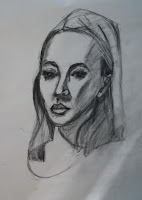 This is the tracing paper overlay that Glen Orbik did over my drawing. You can see how good he is. Mark Westermoe used to put the tracing paper overlays over our drawings and fix them too. I think it is a method that they must have learned from Fred Fixler who the both studied under at the California Art Institute.
This is the tracing paper overlay that Glen Orbik did over my drawing. You can see how good he is. Mark Westermoe used to put the tracing paper overlays over our drawings and fix them too. I think it is a method that they must have learned from Fred Fixler who the both studied under at the California Art Institute.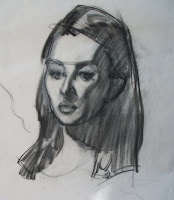 This is a basic lay in the Glen helped me with. He is great in the class he gives you lots of attention.
This is a basic lay in the Glen helped me with. He is great in the class he gives you lots of attention.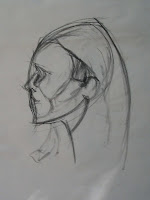 This is a 5 minute drawing I did. I tend to be really heavy handed with the charcoal. I need to do some pressure exercises.
This is a 5 minute drawing I did. I tend to be really heavy handed with the charcoal. I need to do some pressure exercises.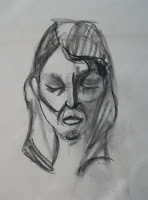
This is another 5 minute drawing. I need to work on these and go somewhere and draw this week but I also have Cathy's class so maybe when her class is over and I will just concentrate on watching the dvds and copying from Loomis and doing the head mapping
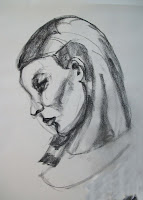
This is a quick sketch will the model was on break.
Keep everything light.
First get the big shape, brow, center line, base of the nose. deep eye set, shape of the nose and then keep it light.
Map out the planes of the head. Put in relationships.
1st phase - Figure out where everything goes
2nd phase - Figure out dark and light shapes (think of it as a crappy xerox)
The drawing is supposed to be what you see when you squint.
Get rid of construction lines
The eye lashes and eyes are part of the same dark shape/
Relate everything.
Posterize light and dark in the hair. And use a big stroke in the hair as a suggestion of texture. The last thing is the extreme darks (or Glen says dipping into the black paint).
Either you are blocking in or honing in. Don't outline features outline the light.
Squint your eyes until you see a shape or a puzzle piece.












































